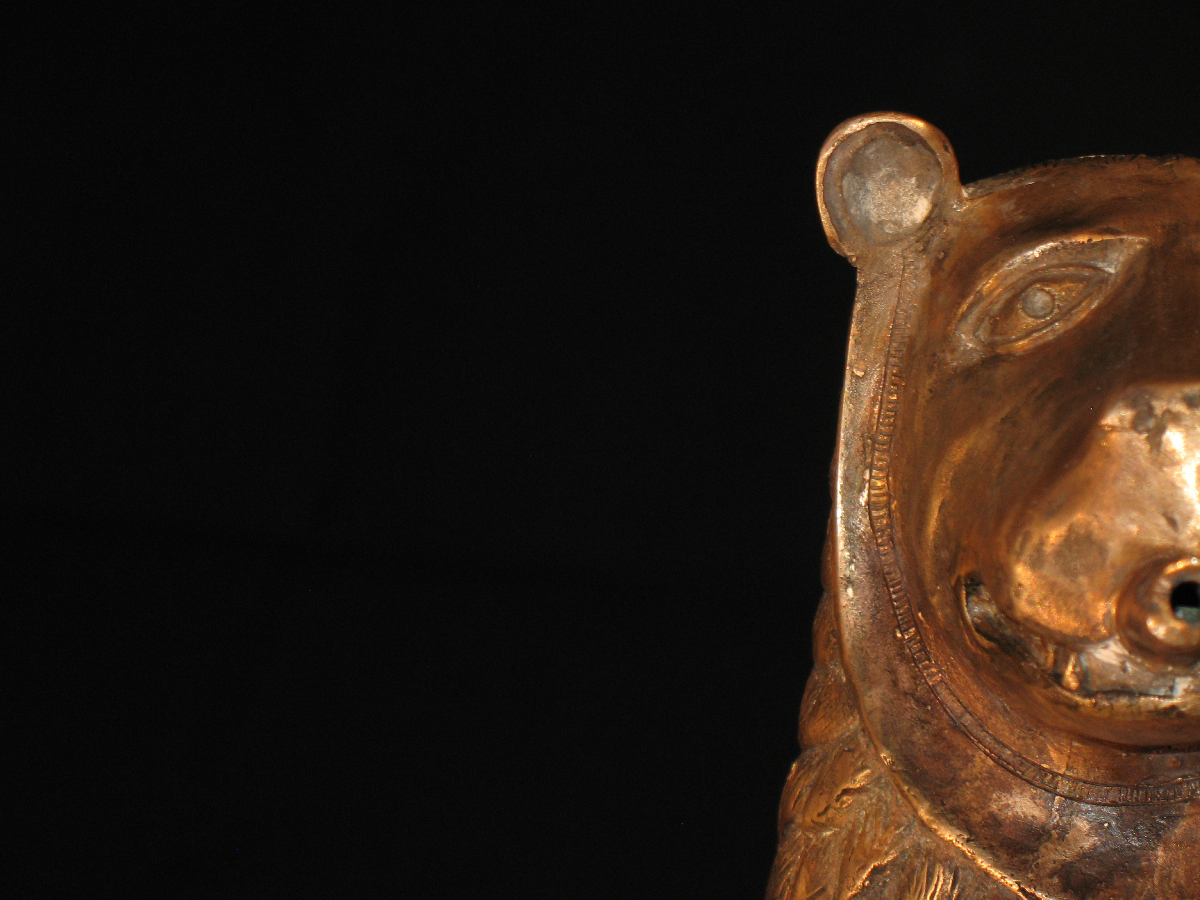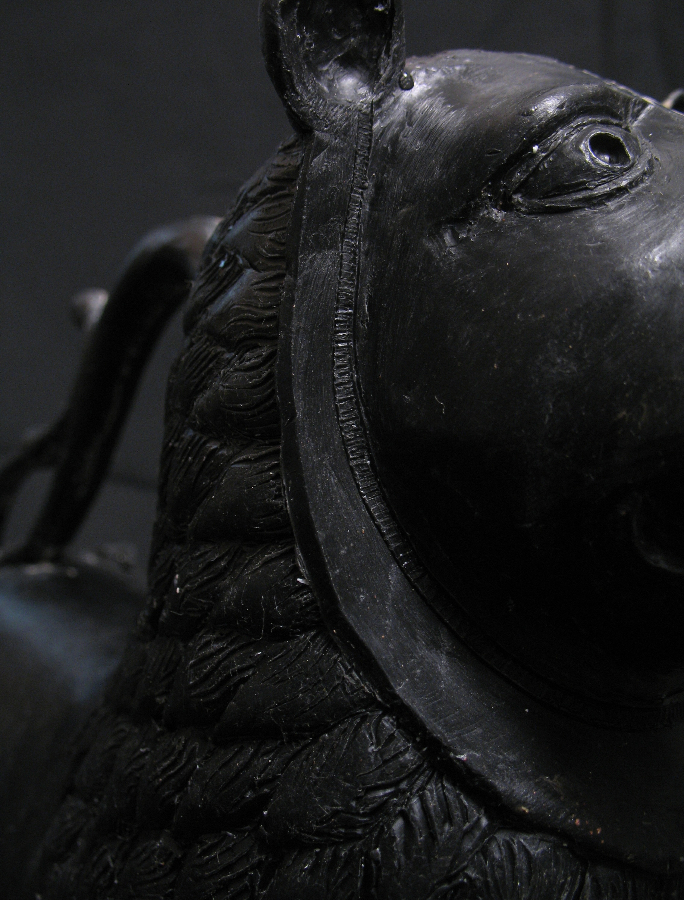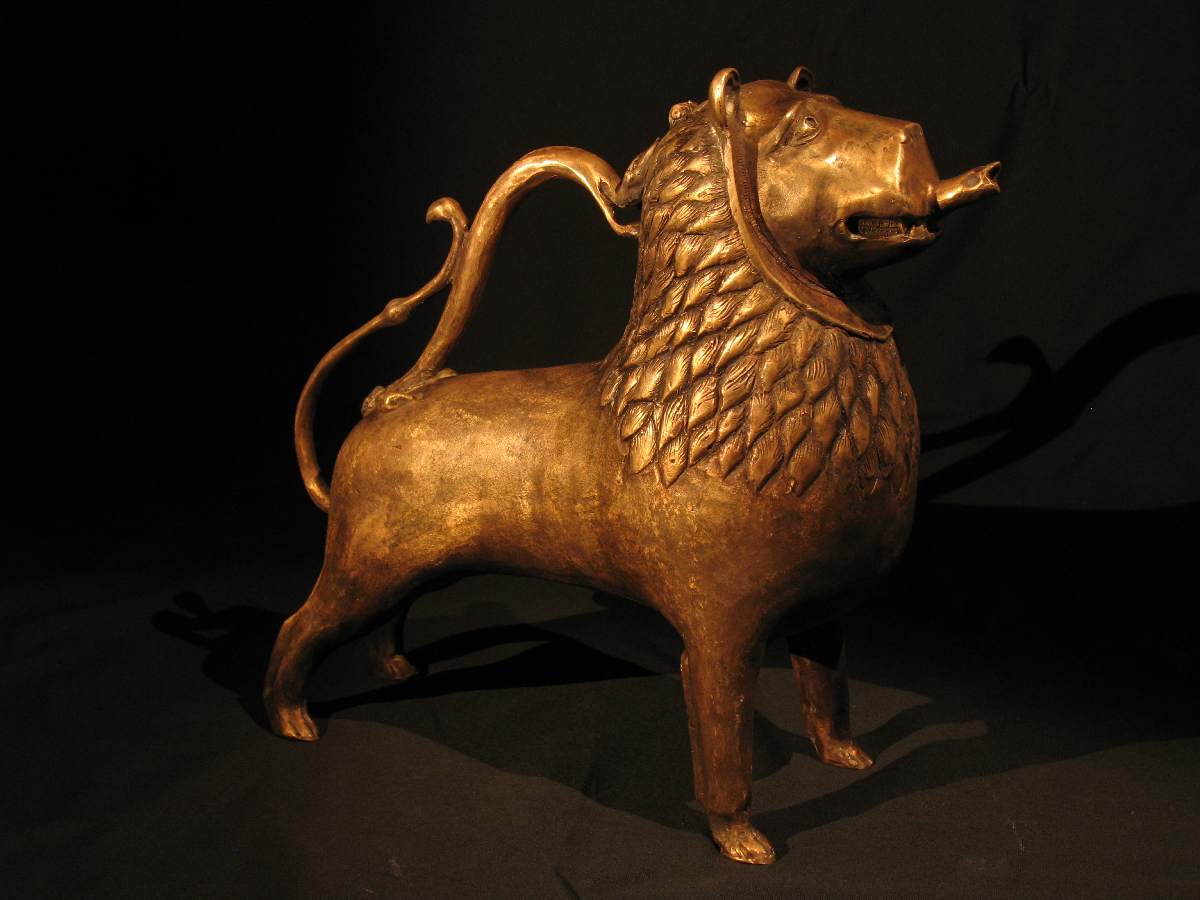Aug
21
2014
Bastian Asmus

The casting of an aquamanile in original medieval technique has been a long term intention of mine. A year ago I made an aquamanile in the form of a lion that dated to the medieval period, however I did not have time to cast that particular aquamanile in a technique that can be considered medieval.- The model however was made with the techniques known to medieval artificers. It was made according to Theophilus Presbyter’s description in his schedula diversarum artium , a 12th century manuscript on artisan’s techniques. Theophilus’ chapter 61 on the making of the cast incense burners provides all the necessary information, with which an informed reader can go ahead an produce a formidable bronze (or any other copper alloy) casting. This information was used to prepare the mould for the casting of this aquamanile. There will be an article shortly on how to make the mould.

Loam mould of the lion aquamanile. The loam mould consists of the same ingredients as medieval moulds.
Casting a medieval aquamanile
The mould was prepared from loam and made three days before the casting. The wax model was molten from the loam mould over embers. The mould was subsequently fired with charcoal. The charcoal was allowed to burn down to the top of the mould and before it was charged again with fresh charcoal. This was repeated three time s, just as Theophilus tells us . The casting was accomplished through the feet; so the mould is placed upside down for the casting. It was cast with a quaternary alloy of copper, zinc, tin and lead. The alloy is CuZn13Sn8Pb2 and was prepared for the casting.
References
{1698736:UT84UXKS};{1698736:UT84UXKS}
apa
default
asc
no
2513
%7B%22status%22%3A%22success%22%2C%22updateneeded%22%3Afalse%2C%22instance%22%3A%22zotpress-3bddd2019566c65f954c68092b7baab8%22%2C%22meta%22%3A%7B%22request_last%22%3A0%2C%22request_next%22%3A0%2C%22used_cache%22%3Atrue%7D%2C%22data%22%3A%5B%7B%22key%22%3A%22UT84UXKS%22%2C%22library%22%3A%7B%22id%22%3A1698736%7D%2C%22meta%22%3A%7B%22creatorSummary%22%3A%22Hawthorne%20and%20Smith%22%2C%22parsedDate%22%3A%221979%22%2C%22numChildren%22%3A0%7D%2C%22bib%22%3A%22%3Cdiv%20class%3D%5C%22csl-bib-body%5C%22%20style%3D%5C%22line-height%3A%202%3B%20padding-left%3A%201em%3B%20text-indent%3A-1em%3B%5C%22%3E%5Cn%20%20%3Cdiv%20class%3D%5C%22csl-entry%5C%22%3EHawthorne%2C%20J.%20G.%2C%20%26amp%3B%20Smith%2C%20C.%20S.%20%281979%29.%20%3Ci%3ETheophilus%3A%20On%20divers%20arts%26%23x202F%3B%3A%20the%20foremost%20medieval%20treatise%20on%20painting%2C%20glassmaking%20and%20metalwork%20%5C%2F%20Theophilus%20%5C%2F%20translated%20from%20the%20Latin%20with%20introduction%20and%20notes%20by%20John%20G.%20Hawthorne%20and%20Cyril%20Stanley%20Smith%3C%5C%2Fi%3E.%20Dover.%3C%5C%2Fdiv%3E%5Cn%3C%5C%2Fdiv%3E%22%2C%22data%22%3A%7B%22itemType%22%3A%22book%22%2C%22title%22%3A%22Theophilus%3A%20On%20divers%20arts%20%3A%20the%20foremost%20medieval%20treatise%20on%20painting%2C%20glassmaking%20and%20metalwork%20%5C%2F%20Theophilus%20%5C%2F%20translated%20from%20the%20Latin%20with%20introduction%20and%20notes%20by%20John%20G.%20Hawthorne%20and%20Cyril%20Stanley%20Smith%22%2C%22creators%22%3A%5B%7B%22creatorType%22%3A%22author%22%2C%22firstName%22%3A%22John%20G.%22%2C%22lastName%22%3A%22Hawthorne%22%7D%2C%7B%22creatorType%22%3A%22author%22%2C%22firstName%22%3A%22Cyril%20Stanley%22%2C%22lastName%22%3A%22Smith%22%7D%5D%2C%22abstractNote%22%3A%22%22%2C%22date%22%3A%221979%22%2C%22language%22%3A%22%22%2C%22ISBN%22%3A%22%22%2C%22url%22%3A%22%22%2C%22collections%22%3A%5B%22RI8HAJ3J%22%2C%22RJ29LLFX%22%5D%2C%22dateModified%22%3A%222013-06-20T13%3A11%3A59Z%22%7D%7D%5D%7D
Hawthorne, J. G., & Smith, C. S. (1979). Theophilus: On divers arts : the foremost medieval treatise on painting, glassmaking and metalwork / Theophilus / translated from the Latin with introduction and notes by John G. Hawthorne and Cyril Stanley Smith. Dover.
1 comment | tags: Aquamanile, aquamanilia, art, casting, Rotgießer, Rothschmied, Theophilus | posted in Archaeometallurgy, Demonstration, Metal casting, practical metallurgy
Jun
27
2013
Bastian Asmus
 A lion aquamanile from Halberstadt, Germany
A lion aquamanile from Halberstadt, Germany

The lion aquamanile you can see here I modelled after the aquamanile from Halberstadt. It is to date one of the very few aquamaniles that is still in its original context (Mende 2008). Aquamaniles, somtimes also referred to asaquamanale, aquimanile, aquamnilia is composed of the the two latin words aqua, for waterr und manus, for hand. The term aquamanile was used differently in medieval times than today: it mostly referred to the receptables of the water in the form of dishes or bowl. In contrast the vessel for pouring water was called urceus, i.e. latin for ewer (Wolter-von dem Knesebeck 2008, 217). Aquamaniles were used for the ritual cleansing of the priest before the mass. Apart from this ecclesiastic use aquamaniles were also to be found in secular households of high social status where they were used before meals.

Detail shot of the wax model
During the last month or so I modelled this 13th century aquamanile and cast it in bronze in my casting workshop using the lost wax technique. The model was made from wax and was prepared over a core of loam, just as it was described by the benedictine monk and artificer Theophilus Presbyter in his schedula diversarum artium in the chapter on the production of the cast incense burner. See here how the article on the casting of the aquamanile went in the reconstructed medieval loam mould.
To this end wax plates were applied to the loam core. This is also described by Theophilus. An alternative way to produce a wax layer of sufficient thickness would have been the repeated dipping into liquid wax. This however was not mentioned by Theophilus and therefore not used. After the wax plates had been applied the finer details, such as the mane or the eyes of the lion were shaped.

Detail shot of the aquamaniles face
The aquamanile weighs 3,6 kg and holds 1.35 l of water. This reconstructed aquamanile may be seen in its original function at the events of the french re-enactment project Fief et chevalerie. Contact me if you would like to purchase this or any other aquamanile.
References:
Ursula Mende 2008.
Catalogue entry 52 in: Michael Brandt (Hrsg), Bild & Bestie. Hildesheimer Bronze der Stauferzeit. 378p. 2008.
Harald Wolter-von dem Knesebeck 2008.
Zur Inszenierung und Bedeutung von Aquamanilien, in: Michael Brandt (Hrsg), Bild & Bestie. Hildesheimer Bronze der Stauferzeit. 2008.
Medieval bronze aquamanile in the form of a lion
Image 1 of 7
Dies ist eine Neuschöpfung des mittelalterlichen bronzenen Löwenaquamaniles von Halberstadt.
Das Original ist im Halberstädter Dommuseum.
This is a lion aquamanile that was made after the medieval bronze aquamanile of Halberstadt. The original is in the Halberstädter Dommuseum.
2 comments | tags: Aquamanile, aquamanilia | posted in Aquamanile, Archaeometallurgy, General, Metal casting, practical metallurgy, Reconstructions




